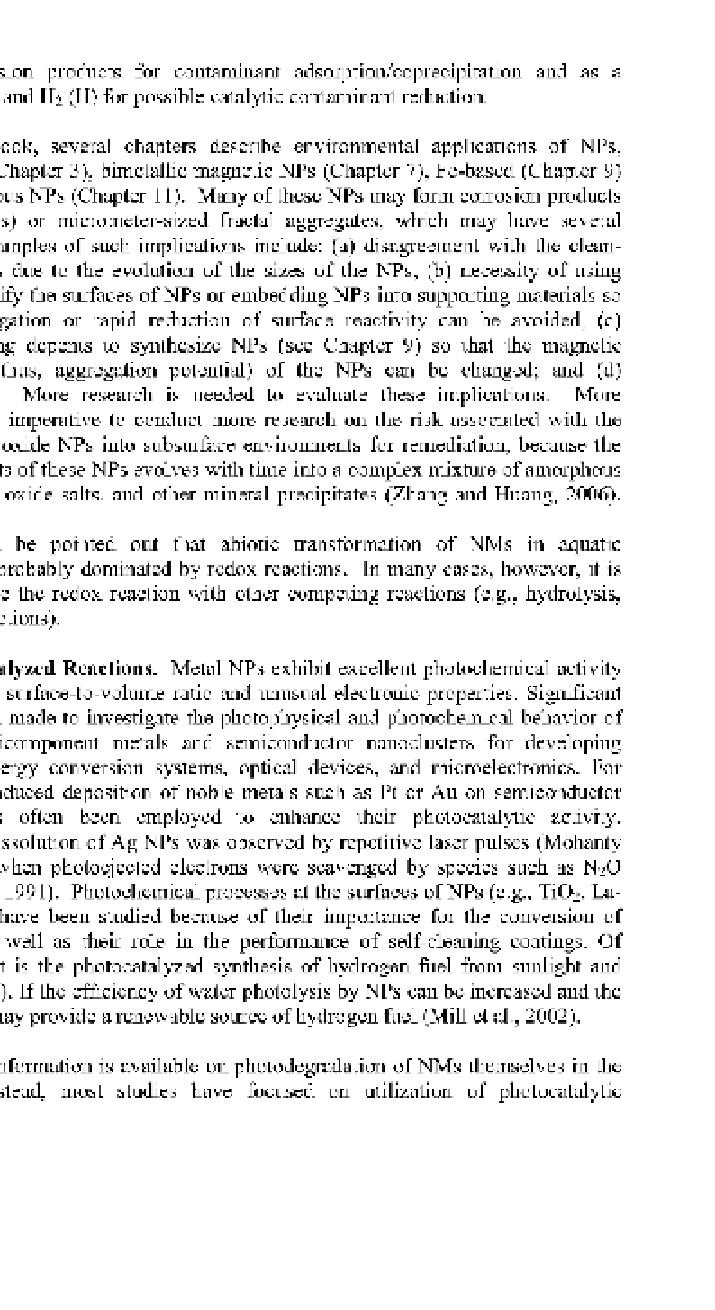Environmental Engineering Reference
In-Depth Information
source of corrosion products for contaminant adsorption/coprecipitation and as a
generator of Fe
+
and H2 (H) for possible catalytic contaminant reduction.
In this topic, several chapters describe environmental applications of NPs,
including TiO2 (Chapter 3), bimetallic magnetic NPs (Chapter 7), Fe-based (Chapter 9)
or nanoscale porous NPs (Chapter 11). Many of these NPs may form corrosion products
(e.g., oxide films) or micrometer-sized fractal aggregates, which may have several
implications. Examples of such implications include: (a) disagreement with the clean-
bed filter models due to the evolution of the sizes of the NPs, (b) necessity of using
polymers to modify the surfaces of NPs or embedding NPs into supporting materials so
that rapid aggregation or rapid reduction of surface reactivity can be avoided, (c)
necessity of using depents to synthesize NPs (see Chapter 9) so that the magnetic
properties (and thus, aggregation potential) of the NPs can be changed; and (d)
associated risks. More research is needed to evaluate these implications. More
importantly, it is imperative to conduct more research on the risk associated with the
injection of iron oxide NPs into subsurface environments for remediation, because the
corrosion products of these NPs evolves with time into a complex mixture of amorphous
iron oxides, iron oxide salts, and other mineral precipitates (Zhang and Huang, 2006).
It should be pointed out that abiotic transformation of NMs in aquatic
environments is probably dominated by redox reactions. In many cases, however, it is
difficult to isolate the redox reaction with other competing reactions (e.g., hydrolysis,
ion exchange reactions).
Photocatalyzed Reactions.
Metal NPs exhibit excellent photochemical activity
due to their high surface-to-volume ratio and unusual electronic properties. Significant
efforts have been made to investigate the photophysical and photochemical behavior of
single and multicomponent metals and semiconductor nanoclusters for developing
efficient light-energy conversion systems, optical devices, and microelectronics. For
example, photoinduced deposition of noble metals such as Pt or Au on semiconductor
nanoclusters has often been employed to enhance their photocatalytic activity.
Photochemical dissolution of Ag NPs was observed by repetitive laser pulses (Mohanty
et al., 2000) or when photoejected electrons were scavenged by species such as N2O
(Mulvaney et al., 1991). Photochemical processes at the surfaces of NPs (e.g., TiO2, La-
doped NaTaOs) have been studied because of their importance for the conversion of
solar energy, as well as their role in the performance of self-cleaning coatings. Of
particular interest is the photocatalyzed synthesis of hydrogen fuel from sunlight and
water (photolysis). If the efficiency of water photolysis by NPs can be increased and the
cost reduced, it may provide a renewable source of hydrogen fuel (Mill et al., 2002).
Limited information is available on photodegradation of NMs themselves in the
environment; instead, most studies have focused on utilization of photocatalytic

Search WWH ::

Custom Search